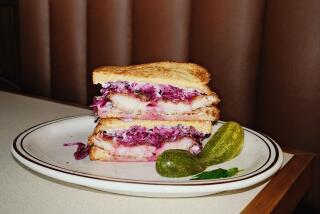Those Bagel Shops: Are They Toast?
- Share via
Bagel shops, home of one of the hottest low-fat food fads of the 1990s, appear to be headed the way of the frozen yogurt stand as more Americans indulge in decadent foods such as doughnuts and ice cream.
On Thursday, the country’s largest bagel chain, Golden, Colo.-based Noah/Einstein Bagel Corp., said it may not have enough money to keep the company operating unless it finds new financing.
The chain, which owns 539 bagel stores nationwide, including more than 50 Noah’s Bagel locations in Southern California, said in its annual report that it will be unable to pay off its $125 million in debt that comes due in October.
The company closed 14 shops across the country last year, including one on Main Street in Santa Monica.
Its biggest rivals have suffered equally in the last couple of years, victims of their own overexpansion as well as slackening bagel sales. Compounding the problem for bagel shops, analysts say, is that bagels can be had almost anywhere these days, from supermarket bakeries to the local Dunkin’ Donuts store.
“There has been an explosion in the availability of bagels,” said Ronald Paul, president of Technomic Inc., a Chicago restaurant consulting firm. “And to the consumer, it’s not worth going out of their way for that.”
The bagel goes back to 1683, when it was invented as a tribute to Polish King Jan Sobieski, who saved Austrians from Turkish invaders. In this century, the bagel, a bread that is boiled and then baked, became a staple of Jewish homes.
The bagel’s modern surge in popularity began about a decade ago with the attempt by many Americans to flee high-fat, high-calorie doughnuts. Although they boast a low fat content, Bagels come packed with more than 300 calories.
The bagel’s brief run of mainstream popularity may be a victim of booming economic times and high living, experts say.
“People seem to be less concerned with fat and the health content” of foods, said Orange County restaurant consultant Robert Sandelman.
With consumer confidence and employment at historically high levels, American consumers appear to be celebrating, Sandelman says. “When people feel happy about themselves and their work, they tend to indulge. They want to treat themselves to the best.”
Some nutritionists say dieters who have been eating low-fat snacks and frozen dinners for almost a decade on the advice of diet gurus without getting leaner are fed up and returning to foods with richer taste and texture.
“They’re going back to a more balanced diet and getting away from being so phobic about fat,” said Ann Grandjean, director of the Center for Human Nutrition in Omaha.
Grandjean suggests that many stressed-out people may be living in the moment, indulging today with the expectation that new fat substitutes and fat-blocking prescription drugs such as Xenical will help them keep their weight under control.
Americans are either tired of experts telling them what’s good or bad for them, or they’re just too tired to care.
Annual U.S. consumption of low-fat and fat-free snacks peaked in 1997 at 22.6 servings per person and declined to 19.7 servings in 1998, the latest year for which statistics are available, according to NPD Group, a Rosemont, Ill.-based research group.
Although doughnut chains such as Krispy Kreme and Winchell’s are racing to open new stores, the big bagel chains are shuttering locations, merging with other chains or trying to make themselves over as sandwich shops. To cater to America’s sweet tooth, many also are adding muffins, scones and other goodies.
“We’re trying to broaden our appeal,” said Robert Hartnett, Noah/Einstein’s chief executive and a former franchisee. “We fit into a category now that I’d call fast casual. We satisfy a variety of needs.”
Since Noah/Einstein began adding sweets and lunch items last year, breakfast bagel sales have shrunk to just 40% of the chain’s business, and it is continuing to add items to its menus.
Noah/Einstein’s overall sales rose 1% to $375.5 million in 1999. Its net loss narrowed to $14.4 million from $203.9 million the previous year as the company focused on cost-cutting and streamlining operations.
But its cash flow is not sufficient to satisfy the company’s $125 million in bond debt, racked up during its peak expansion years of 1995 to 1997, which will mature this fall.
The company opened more than 200 stores in 1997, a staggering amount for any chain. Hartnett concedes that not all of those new locations were good ones.
The company is now trying to persuade its minority investors or its bondholders to trade that debt for a large stake in the company.
Eatontown, N.J.-based New World Coffee-Manhattan Bagel Inc., the country’s No. 2 bagel chain, also is reportedly interested in acquiring the company.
New World CEO Ramin Kamfar would not confirm or deny those reports.
Noah/Einstein’s crushing debt load and its sluggish sales have pushed the company’s stock price down 76% in the last year. It was delisted from the Nasdaq Stock Market on March 7.
Kamfar also has been trying to reinvent his Manhattan Bagel chain as more of a sandwich place after scooping it up out of bankruptcy in 1998. Besides bagels, the company now offers wrap-style sandwiches and gourmet coffee from its chain of specialty coffee shops.
“Coffee is definitely an important element,” Kamfar said.
Analysts say the biggest blow to the bagel chains hasn’t come from supermarkets or doughnut shops but from America’s fast-growing java joints, which have been expanding their food offerings.
“People are saying, ‘Give me the convenience that I want and the coffee that I want,’ ” restaurant consultant Sandelman said. “They think, ‘A bagel is a bagel. How much different is it going to be if I get it from Starbucks or Noah’s?’ ”
(BEGIN TEXT OF INFOBOX / INFOGRAPHIC)
Dollars to Doughnuts
Industry experts say customers are moving away from bagels and back to more decadent foods, including doughnuts, as people become less obsessed with counting grams of fat.
*
Sources: Noah’s, Krispy Kreme,
The Complete Book of Food Counts
More to Read
Inside the business of entertainment
The Wide Shot brings you news, analysis and insights on everything from streaming wars to production — and what it all means for the future.
You may occasionally receive promotional content from the Los Angeles Times.










